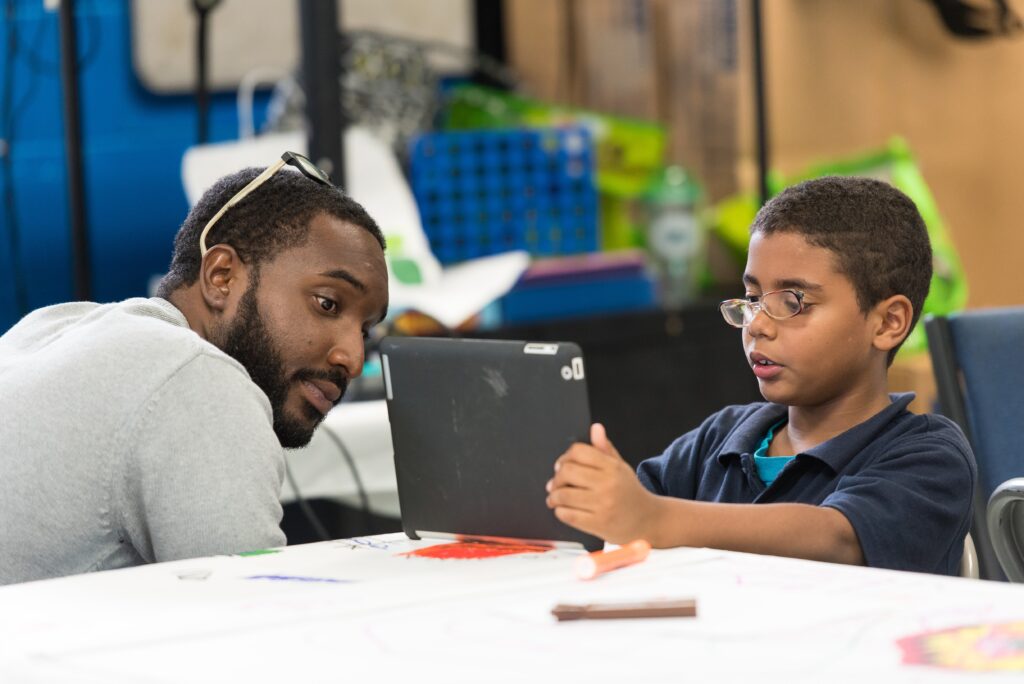
Personalized Learning Squared (PL2) is a collaboration fostered by Remake Learning between the University of Pittsburgh’s Center for Urban Education (CUE) and Carnegie Mellon University’s LearnLab. By pairing the power of human tutors with artificial intelligence (AI), project leaders hope to target opportunity gaps for students of color and other marginalized groups, piloting innovative approaches to personalized learning. Currently in a pilot phase, PL2 is being implemented and co-designed at four locations across the Pittsburgh region: Pittsburgh Public Schools (PPS), Propel Charter Schools, Shaler Area School District, and Elizabeth Forward School District.
Cassandra Brentley is program manager for Ready to Learn, an after-school program that connects PPS students with Pitt undergraduate students for mentoring and math tutoring. She is facilitating participation in PL2 for middle-school students in PPS’s Westinghouse Academy 6–12 and Pittsburgh Milliones 6-12, University Preparatory School. A doctoral student at CUE, Brentley’s research focuses on preparing students to thrive in the “Fourth Industrial Revolution” by navigating ever-changing technology and the future of work.
We spoke with Brentley about the promise of PL2 and her work in co-developing it.
What makes personalized learning so powerful?
Being able to work one-on-one with students is ideal. That’s nothing new. But it’s often seen as an intervention. We have this idea of having individualized education programs for students because they need something different. But in reality, all of our students need something different. All of our students need their learning personalized to their interests and their skill level because all of our students learn different things at different rates. Oftentimes the barrier is we just don’t have the resources to do that. We’d love to have a one-to-one student-teacher ratio, but that’s not practical.
How does AI enhance that potential?
So, the power of AI is that it’s able to personalize the learning environment for each student. Now if you talk to any educator, they will tell you that you can’t just throw software into a situation and expect all of your problems to be solved. What you really need is to have a person there interpreting what students are doing and take it to that next level to truly personalize the experience by being able to look at the learning analytics and say, ‘You did an amazing job in ratios, but when you got to areas of a square, you really struggled. Let’s do some one on one things, get out a paper and pencil and write it out.’
You have to really be able to look at what each student is doing individually and see if this program is working because I think technology alone is not the solution.
What has the process of developing PL2 been like?
We are actively using [math-learning software] Mathia in each of our [tutoring] sessions for about 30 minutes. Learning analytics from these sessions get put into the PL2 app in ways to make it meaningful for mentors, and after each session we debrief on what went well, what opportunities do we see, how are students interacting, and what we can do better.
The dynamic piece of the app that is still being built out is the resources. The app can recommend, “Your student’s really struggling with fractions, here are some videos and other resources you can do with your students to build their skills in that area.”
Can you talk about PL2 in terms of culturally responsive teaching?
People often see math as a subject that is without culture, which isn’t really true. There are definitely opportunities to bring culture and real-world relevance into math and that’s what we’re trying to do, is to show students the utility of math and how it shows up in their everyday lives. We’re trying to really empower them in approaching math problems that seem difficult.
Our goal is just to give them the hope so they know you really can achieve anything. We’re going to try to put these opportunities in front of you as often as we can so you’re inspired and know that you can truly do whatever you set your mind to and these are the things you might have to do to achieve that.
And that’s why the culturally relevant, real-world piece is so essential—to show how you are going to use this, what you’re going to need this for, what professions use this daily, to begin to have students thinking differently about the utility of it and why it’s important.
What else would you like people to know about PL2 or Ready to Learn?
A lot of the issues the students are experiencing in school are adult issues. We talk about AI: adult issues. They’re not given the opportunities, they don’t have access to the same types of resources that students in other schools have.
The students I’ve had the pleasure of working with so far at U Prep have been eager and engaged to show up after school twice a week to do math. This summer they came for three hours, twice a week, at nine o’clock in the morning on summer break, to do math, and were super engaged. They brought friends to the program to do math with them. And I feel like that’s not highlighted enough.
PL² and Remake Learning’s coverage of the project are supported by a grant from the Chan Zuckerberg Initiative.
